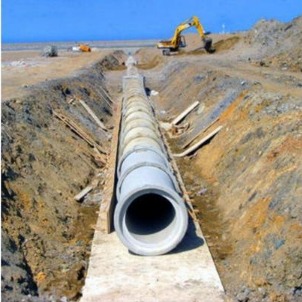🕑 Reading time: 1 minute
Reinforced concrete pipes (RCP) display widespread applications in storm sewer systems, large irrigation projects, and sanitation systems. In comparison with high-density polyethylene plastic pipes (HDPE), RCPs have higher strength and durability.
The inherent strength of RCP makes its installation and backfilling procedures simple. RCP is heavy and demands proper handling during transportation and installation.
This article explains some of the basic steps involved in the installation of a reinforced concrete pipe (RCP).
Contents:
Installation of Reinforced Concrete Pipe (RCP)
The basic steps involved in the installation of RCP are:
- Material handling
- Excavation
- Preparation of joints
- Installation of RCP
- Backfilling
1. Handling of RCP Material
Reinforced concrete pipes require proper and safe handling operation. The two main parts of RCP are the bell and spigot. The wide and flared ends of the pipes are called bell and the narrow end of the pipe used to join into the bell of the adjacent pipe is called a spigot. Both these parts require special care while handling.

It is better to handle and unload the RCP using a nylon sling or any good-quality material that can support the weight of the RCP. While handling, the pipe must be balanced precisely for better safety.
2. Excavation for Reinforced Concrete Pipe
The trenches excavated to install RCP must be wide enough to accommodate two pipes. This space provision helps to adjust the slope and perform any trenching operation without damaging the concrete pipes. This can also help in ensuring workers’ safety.

Once the trench is excavated, the next process is to set the grade of the pipe (slope of the pipe). After which, a bedding layer is provided. The bedding provided must be leveled and free from debris.
Never place the pipes over the bedding layer on their bells before installation as this can damage the bells.
3. Preparation of Joints for Reinforced Concrete Pipes
The bell of the concrete pipe must be cleaned from dirt. Apply a lubricant to the pipe bell using a brush before joining the concrete pipes.

The lubricant used must not make the gasket roll away and damage the ends of the pipes. To ensure a good seal with the joint gasket, the spigot or tongue of the concrete pipe must be cleaned and lubricated.
4. Installation of Reinforced Concrete Pipes
Generally, the installation of concrete pipes requires a minimum of two workers. The large pipe is placed in the trench at first. This can be performed by means of a crane or backhoe, while workers assist in the proper placing of pipes in the trench.
The spigot end of the pipe is inserted into the bell of the pipe already installed. Then the new section is installed on the pipe using a crowbar or pipe pullers.

Once the new section is properly seated, the workers must ensure the alignment of the pipe using surveying or leveling instruments.
5. Backfilling for RCP
Backfilling is the final process of RCP installation. The backfill material is initially placed on either side of the pipe. The material must not be bulldozed or dropped directly into the trench. The backfill material must not include boulders that can damage the pipe during compaction. The backfill must be free from roots or any organic matter.

After backfilling and compacting, the trench is filled to the required grade as per the project specifications. Ensure that the pipe is deep below the ground before driving any heavy construction equipment over it.
Frequently Asked Questions
The basic steps involved in the installation of reinforced concrete pipe include:
1. Handling the reinforced concrete pipe
2. Excavation of trenches to lay concrete pipe
3. Preparation of joints to connect the concrete pipes
4. Installation of concrete pipes
5. Backfilling
Generally, the installation of concrete pipes requires a minimum of two workers. The large pipe is placed in the trench at first. This can be performed by means of a crane or backhoe, while the workers assist in the proper placing of pipes in the trench.
The spigot end of the pipe is inserted into the bell of the pipe already installed. Then the new section is installed on the pipe using a crowbar or pipe pullers.
Once the new section is properly seated, the workers must ensure the alignment of the pipe using surveying or leveling instruments.
Backfilling is the final process of RCP installation. The backfill material is initially placed on either side of the pipe. The material must not be bulldozed or dropped directly into the trench. The backfill material must not include boulders, that during compaction can damage the pipe. The backfill must be free from roots or any organic matter.
After backfilling and compacting, the trench is filled to the required grade as per the project specifications. Ensure that the pipe is deep below the ground before driving any heavy construction equipment over it.
Read More
What is the laying and jointing procedure for concrete pipes?



